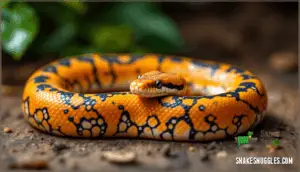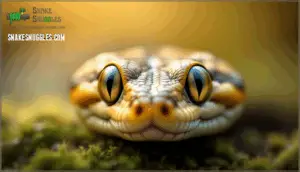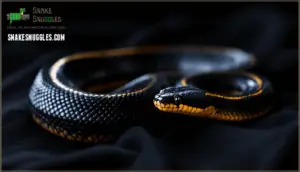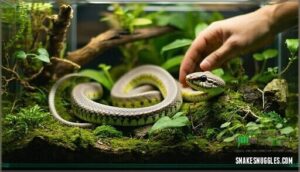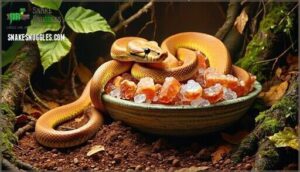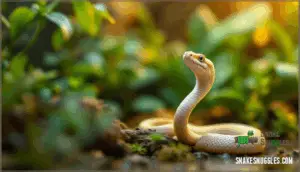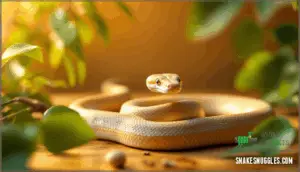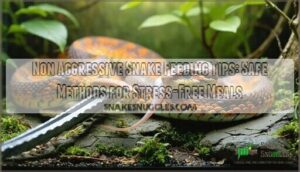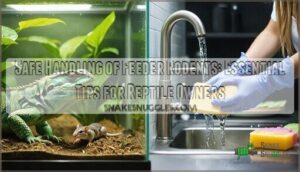This site is supported by our readers. We may earn a commission, at no cost to you, if you purchase through links.
 The first scaleless corn snake emerged from a breeding project in 2005, a genetic anomaly that transformed our understanding of what’s possible in captive snake breeding. This smooth-skinned mutation removes the protective scales that define most serpents, leaving behind skin that feels like wet silk against your fingertips.
The first scaleless corn snake emerged from a breeding project in 2005, a genetic anomaly that transformed our understanding of what’s possible in captive snake breeding. This smooth-skinned mutation removes the protective scales that define most serpents, leaving behind skin that feels like wet silk against your fingertips.
The trade-off for this velvety texture isn’t trivial—without their armor, these snakes demand careful humidity control and gentler care than their scaled cousins. Yet breeders continue pursuing the trait, combining it with existing morphs to reveal color intensities that normal scales would mask.
Understanding their unique needs before bringing one home separates successful keepers from those who watch their investment suffer preventable skin infections.
Table Of Contents
- Key Takeaways
- What is a Scaleless Corn Snake?
- What Do Scaleless Corn Snakes Look Like?
- Do Scaleless Corn Snakes Make Good Pets?
- Scaleless Corn Snake Care and Habitat
- Feeding Your Scaleless Corn Snake
- Keeping Your Scaleless Corn Snake Healthy
- Scaleless Corn Snake Breeding and History
- Unique Features and Traits of Scaleless Corn Snakes
- Handling and Living With Scaleless Corn Snakes
- Are Scaleless Corn Snakes Right for You?
- Frequently Asked Questions (FAQs)
- Are corn snakes the same thing as rat snakes?
- Is a corn snake and a chicken snake the same?
- Do corn snakes ever bite?
- Do corn snakes like sand?
- What are scaleless corn snakes?
- Do scaleless snakes have health issues?
- Can scaleless snakes survive?
- Are scaleless corn snakes ethical?
- How long do scaleless corn snakes live?
- Can scaleless corn snakes climb?
- Conclusion
Key Takeaways
- Scaleless corn snakes resulted from a 2005 recessive EDARADD gene mutation that removes protective scales, creating smooth, velvety skin that intensifies color saturation but demands strict humidity control (65-75%) and soft substrates to prevent skin infections and abrasions.
- These snakes require more attentive care than scaled morphs—including regular misting schedules, frozen-thawed prey only (to avoid bite wounds), cypress mulch bedding, and weekly skin inspections—making them suitable for dedicated keepers rather than casual hobbyists.
- The scaleless trait combines with existing color morphs (Albino, Tessera, Anery, Blizzard) through predictable recessive inheritance patterns, producing 25% scaleless offspring when both parents carry the gene and commanding premium prices of $150-$4,000 in the breeding market.
- Despite their delicate appearance, scaleless corn snakes maintain comparable activity levels and 15-20 year lifespans to scaled varieties when provided appropriate housing (20-30 gallon tanks with 70-88°F gradients) and gentle handling techniques that protect their vulnerable epidermis.
What is a Scaleless Corn Snake?
A scaleless corn snake is a genetic variant of the popular corn snake that lacks most or all of its typical scales, resulting in smooth, velvety skin. This mutation creates a distinctly different appearance and texture compared to their normally scaled relatives.
Understanding the genetics and morphs available helps you make informed decisions about acquiring these unique reptiles.
Scaleless Corn Snake Morphs
The scaleless mutation opens the door to a stunning palette of morphs, each pairing the signature smooth skin with different color and pattern genetics. You’ll encounter Scaleless Albino corn snakes displaying vivid orange-red hues, their pigmentation uninhibited by keratinized scale layers. Scaleless Tessera morphs showcase disrupted pattern development, with lateral striping replacing traditional saddles. For those drawn to monochromatic specimens, Scaleless Anery morphs present gray and brown tones through melanin reduction. The Scaleless Blizzard represents combined amelanism and anerythrism, yielding nearly white individuals.
Each morph classification demonstrates how color variations and pattern development interact independently from the scaleless trait itself.
Snake breeding programs continue expanding these combinations, though responsible morph genetics practices remain essential. These snake morphs prove that scaleless corn snakes offer extraordinary diversity beyond their distinctive texture.
Scaleless Corn Snake Genetics
Understanding how scaleless genetics work gives you real insight into what you’re bringing home. You’re looking at a recessive gene mutation that requires both parents to carry the variant for scaleless offspring to hatch. This genetic mutation stems from a deletion in the EDARADD gene, specifically affecting exon 6—the blueprint for scale development.
DNA sequencing of breeding lines confirms complete concordance between this deletion and the scaleless phenotype across 67 snakes tested. When both parents carry the gene, you’ll see roughly 25% scaleless hatchlings, 25% normal-scaled, and 50% carriers. That’s genetic variation in action.
Heritability studies track how reliably this trait passes through generations, and gene expression research reveals why ventral scales persist while dorsal ones vanish. This recessive gene mutation in snakes demonstrates predictable inheritance patterns breeders depend on. Breeders must research scaleless snake care to guarantee proper maintenance of these unique animals.
What Do Scaleless Corn Snakes Look Like?
If you’re curious about how these unique snakes actually look, you’re in for a fascinating visual experience. Their appearance sets them apart from typical corn snakes in several striking ways.
Let’s break down the key physical features that make scaleless corns so distinctive.
Scaleless Corn Snake Appearance
When you first lay eyes on one, the most striking feature is the smooth, almost velvety texture that replaces the typical overlapping scales you’d expect to find on any other corn snake. This mutation gives scaleless snakes a wrinkled appearance when they coil. Their velvety skin reveals intensified color saturation—oranges, reds, and tans appear more vibrant without scales diffusing the pigmentation.
The scaleless corn snake’s smooth, velvety skin reveals intensified colors and creates a wrinkled appearance when coiled, replacing typical overlapping scales with striking visual vibrancy
Here’s what sets their appearance apart:
- Reduced dorsal scales with occasional tiny round scales scattered along the back
- Blobby color patterns with thick black borders that fade toward the center
- Enhanced color saturation making their natural hues more vivid
- Wrinkled texture that becomes prominent during movement and coiling
Nearly Scaleless Heads With Large-Appearing Eyes
Beyond the smooth body, their heads catch your attention immediately—those eyes seem to take up almost half the face, sitting exposed without the usual frame of protective scales. This head morphology makes them look vulnerable yet enchanting. Without eye scales, you’ll notice their facial features appear more delicate. The dorsal area transitions smoothly to the scaleless head, creating that signature velvety appearance that sets these scaleless snakes apart from their scaled relatives.
| Feature | Scaleless Corn Snake | Standard Corn Snake | Care Impact |
|---|---|---|---|
| Eye Structure | Enlarged appearance, no protective eye scales | Normal size with protective scales | Requires careful monitoring for ocular health |
| Head Morphology | Nearly scaleless, smooth contours | Fully scaled with defined plates | More sensitive to abrasion and injury |
| Facial Features | Exposed, delicate tissue | Protected by keratinized scales | Needs appropriate substrate to prevent damage |
| Scaleless Vision | Unobstructed but vulnerable | Protected visual field | Watch for eye infections during shedding |
| Overall Protection | Minimal barrier against environment | Natural armor present | Humidity maintenance becomes critical |
Soft and Silky Feel to Their Skin
Running your fingers across a scaleless corn snake feels like touching liquid silk—there’s none of that familiar reptilian roughness, just pure velvety smoothness that wrinkles gently as the snake coils. This striking skin texture comes from scale loss affecting the dermis structure—without that protective keratinized layer, you’re touching raw epidermis.
The velvety feel extends across the dorsal area, creating a unique sensory perception during interaction. Your scaleless corn snake’s soft feel demands gentler interaction than scaled relatives require.
Do Scaleless Corn Snakes Make Good Pets?
You might wonder if these smooth-skinned snakes make suitable companions. The truth is, scaleless corn snakes can be excellent pets for both beginners and experienced keepers, but their care requires understanding a few key considerations.
Let’s address the most important factors you’ll need to know before bringing one home.
Addressing Misconceptions About Scaleless Snake Ownership
You might assume scaleless snakes are delicate, but that’s a fragility myth worth busting. Scaleless corn snakes retain most belly scales and show comparable activity levels to scaled morphs in proper conditions. Their scaleless genetics—a recessive mutation like albinism—doesn’t cause inherent health problems.
The real owner responsibilities? Soft substrate, humidity control, and understanding reptile ethics around responsible breeding. With attentive snake care, these pet snakes thrive just as vigorously as their scaled cousins, proving reptile ownership success hinges on knowledge, not scales.
Proper snake care involves maintaining a suitable thermal gradient and reptile carpet options to guarantee the health and well-being of the pet.
Emphasizing Importance of Providing Suitable Housing
Your scaleless corn snake’s enclosure isn’t just a box—it’s the foundation of their health, and getting the setup right from day one prevents most common problems down the road.
Consider these essential terrarium setup factors:
- Tank size: 20-30 gallons minimum for adults
- Substrate options: Cypress mulch protects delicate skin
- Temperature gradients: 70-88°F range with proper ventilation systems
- Humidity control: 65-75% prevents dehydration
This reptile habitat foundation keeps your snake thriving.
Preventing and Recognizing Skin Damage
Without scales to shield them, these snakes face skin threats that would bounce right off their scaled cousins—so catching early warning signs can mean the difference between a quick fix and a serious health crisis. Check your scaleless corn snake’s skin weekly for lesions, abrasions, or discoloration.
Maintain humidity between 65-75% to prevent dehydration cracks during shedding. Avoid rough substrates that cause skin injuries—cypress mulch works best. Keep heating elements away from direct contact to prevent burns.
This genetic mutation means wound healing takes longer, so prevention beats treatment every time.
Scaleless Corn Snake Care and Habitat
Setting up the right habitat for your scaleless corn snake isn’t complicated, but it does require attention to a few key details.
These snakes need specific conditions to keep their delicate skin healthy and prevent common issues. Let’s look at what you’ll need to create a comfortable home for your scaleless friend.
Habitat, Tank Conditions & Setup
Creating the right home for your scaleless corn snake isn’t rocket science, but getting the details right makes all the difference between a thriving pet and a stressed one.
You’ll need a 20-30 gallon tank with proper ventilation systems to maintain air quality in your captive snake environment. The temperature gradient should range from 70 to 88°F, with a basking spot reaching 90°F—this allows your snake to thermoregulate naturally. Humidity control sits between 65-75%, essential for protecting that delicate skin.
For substrate options, cypress mulch works beautifully, creating a comfortable reptile habitat and environment while supporting appropriate humidity levels.
Regular Misting for Humidity Maintenance
Think of misting as the spa treatment that keeps those vulnerable, scale-free bodies from turning into dried-out leather. Without scales, your snake’s skin health depends entirely on proper humidity control within the reptile habitat and environment. You’ll want to establish a consistent misting schedule that maintains humidity levels between 65-75%, working alongside your temperature gradient to create ideal tank maintenance conditions.
Here’s your action plan for snake care and maintenance:
- Mist the enclosure 2-3 times weekly, adjusting frequency based on your humidity level readings.
- Use dechlorinated water or reptile-safe water quality standards to prevent skin irritation.
- Monitor substrate moisture—it should feel slightly damp but never waterlogged or completely dry.
Special Dietary Requirements
Feeding your scaleless corn snake isn’t about tossing any rodent into the tank and calling it a day. These delicate creatures need a rodent-based diet with strategic nutrient balance to thrive. Without scales providing physical protection, proper mineral intake and vitamin needs become non-negotiable for maintaining ideal snake health. Your feeding habits directly influence skin integrity, skeletal development, and overall vitality.
| Dietary Component | Why It Matters for Scaleless Morphs |
|---|---|
| Frozen-thawed rodents | Prevents feeding-related skin trauma and injury |
| Calcium supplements | Sustains metabolic bone health and prevents deficiencies |
| Vitamin D-3 enrichment | Compensates for reduced content in frozen prey |
| Varied prey sizes | Maintains proper digestion without regurgitation risk |
| Fresh water access | Critical for hydration and preventing skin lesions |
Feeding techniques matter just as much as what you offer. Dust prey items with reptile-specific dietary supplements every few feedings, and replace those powders every six months to maintain potency. Use feeding tongs to minimize strike-related injuries to that vulnerable skin. Keep feeding habits consistent—juveniles every 5-7 days, adults every 14-21 days—and never exceed prey items 1.5 times your snake’s mid-body width.
Feeding Your Scaleless Corn Snake
Feeding your scaleless corn snake doesn’t require a complicated approach, but understanding their nutritional needs makes certain they thrive. You’ll want to focus on appropriate prey size, feeding frequency, and why frozen-thawed options work best for their delicate skin.
Let’s look at what keeps these snakes healthy and well-fed.
Diet and Nutrition Requirements
Your corn snake’s nutrition isn’t just about tossing food into the tank—it’s about building a foundation for long-term health and vitality. Feed appropriately sized mice or rats based on your scaleless corn snake’s girth—prey should match the widest part of their body. Maintain a consistent feeding schedule: juveniles eat every 5-7 days, while adults thrive on weekly to bi-weekly meals.
Proper hydration methods include providing fresh water in a bowl large enough for soaking. Calcium supplement needs arise primarily through whole prey consumption, which delivers essential nutrients naturally.
Monitoring food variety and nutrient balance prevents deficiencies and supports superior snake health and wellness throughout your reptile care journey.
Feeding Frozen-Thawed Rodents for Optimal Health
Once you’ve got the right food source locked in, the next step is preparing those meals the safest way possible. Frozen-thawed rodents are the ideal choice for a scaleless corn snake diet and reptile care. This feeding technique protects your snake’s delicate skin from bites while securing proper rodent nutrition and snake health and wellness.
Here’s your meal scheduling checklist:
- Thaw rodents in the refrigerator overnight, then warm in sealed bags submerged in warm water
- Match prey size to your snake’s girth for ideal snake digestion
- Feed juveniles every 5-7 days, adults weekly
Proper animal husbandry means avoiding live prey entirely—your scaleless friend’s skin can’t risk the damage. Food allergies are rare, but watch for unusual reactions after meals.
Keeping Your Scaleless Corn Snake Healthy
Your scaleless corn snake’s delicate skin makes it more vulnerable to certain health problems than scaled varieties. Staying ahead of these issues means knowing what to watch for and when to act.
Let’s look at the common concerns and practical prevention steps, and how veterinary care fits into keeping your snake thriving.
Common Health Issues
Scaleless Corn Snake health challenges aren’t a walk in the park—respiratory problems and skin infections top the list due to their delicate, scale-free skin. Without proper humidity management (65-75%), your snake risks dysecdysis and bacterial infections. Feeding challenges can arise from live prey causing skin damage, so stick with frozen-thawed rodents. Regular veterinary care is essential for catching parasites, obesity, and blister disease early.
Here’s what to watch for:
| Health Issue | Warning Signs |
|---|---|
| Respiratory Problems | Wheezing, mucus discharge, mouth breathing |
| Skin Infections | Redness, swelling, lesions on body |
| Dysecdysis (Shed Issues) | Retained skin, incomplete shedding |
| Blister Disease | Fluid-filled bumps, discolored patches |
| Parasites & Obesity | Weight loss/gain, lethargy, poor appetite |
Understanding Scaleless Corn Snake Characteristics means recognizing their vulnerability. Reptile Breeding and Genetics created these beauties, but Animal Health and Wellness requires your vigilance. Snake health isn’t just about feeding—it’s about creating an environment where Scaleless Corn Snake Health thrives through consistent monitoring and proactive care.
Prevention Measures
Without the armor of scales, your snake’s skin becomes its most vulnerable frontier—so prevention starts with the basics you can control every single day. Humidity Control between 65-75% prevents dysecdysis and skin infection, while proper substrate choice minimizes abrasions. Respiratory Care depends on maintaining temperature gradients and ventilation. Health Monitoring through weekly inspections catches early signs of scale loss complications before they escalate.
Your prevention toolkit includes:
- Consistent misting schedules and hygrometer checks for ideal moisture
- Smooth substrate like cypress mulch that won’t damage delicate skin
- Frozen-thawed prey only—live rodents cause unnecessary wounds
These Animal Health and Wellness practices form your scaleless corn snake’s first line of defense in Reptile Care.
Veterinary Care
Even the healthiest scaleless corn snake benefits from a partnership with an experienced reptile veterinarian who understands the unique vulnerabilities of scale-free skin. Reptile specialists trained in herpetology studies recognize subtle signs of dermal infection or dysecdysis that general practitioners might miss.
Schedule health checks biannually, and don’t hesitate with emergency care if you observe respiratory distress or skin lesions. While veterinary costs and snake insurance considerations vary, investing in preventive care protects your investment in snake breeding and reptile morphology mastery.
Scaleless Corn Snake Breeding and History
The scaleless trait in corn snakes emerged from a fascinating genetic mutation that breeders quickly recognized for its potential. Since then, dedicated hobbyists have worked to combine this scaleless gene with various color morphs, creating snakes that are both unique and increasingly sought after.
Here’s what you need to know about how these extraordinary reptiles came to be and how they’re bred today.
Unlocking New Color and Pattern Combinations
Genetic variations within the scaleless trait open doors to remarkable morph combinations you won’t find in typical scaled corn snakes. Since 2012, breeders have merged the scaleless mutation with over 20 distinct color patterns—like Snow, Lavender, and Tessera—creating specimens that show enhanced color saturation and modified pattern formation. This morphological variation stems from the gene’s compatibility with existing pigment loci, allowing you to explore:
- Color genetics: Pairing scaleless with Butter or Anery morphs intensifies hue vibrancy.
- Pattern Diversity: Combining with Motley or Stripe genes yields linear or merged dorsal markings.
- Morph Combinations: Compound forms like "Snow Scaleless Stripe" demonstrate reproducible breeding techniques.
Each cross unlocks new Scaleless Corn Snake Morphs, expanding what’s possible in captive collections.
Developing Scaleless Snakes With Increased Popularity
If you think breeding scaleless corn snakes is just a niche hobby, the exploding waitlists and premium prices tell a different story. Market trends show these genetic mutations commanding $150 to $4,000, driven by their velvety skin and intensified coloration.
Breeding techniques now merge snake conservation goals with genetic research, as reptile-keeping enthusiasts recognize scaleless snakes as both biological curiosities and collectible morphs.
Popularity factors include their docile temperament and compatibility with existing color genetics, making scaleless corn snake breeding a legitimate frontier in herpeticulture.
Captive Breeding of Scaleless Snakes
Breeding scaleless corn snakes in captivity isn’t just about pairing two snakes and hoping for the best—it demands a working knowledge of recessive genetics and careful selection of breeding stock. You’ll need to identify het carriers through genetic research and breeder networks, as scaleless morphs only appear when both parents carry the mutation. Captive-bred snakes offer advantages in health monitoring and temperament. Successful breeding techniques involve painstaking reptile care, tracking lineages, and understanding how this genetic mutation interacts with other morph combinations to reveal striking scaleless corn snake variations.
Key considerations for captive selection:
- Verify genetic lineage through documented breeder networks before purchasing breeding stock
- Prioritize healthy specimens with no skin damage or respiratory issues
- Select compatible morphs to optimize color intensity in scaleless offspring
- Maintain detailed records of snake breeding outcomes for future genetic research
Unique Features and Traits of Scaleless Corn Snakes
Scaleless corn snakes stand out from their scaled cousins in ways that go beyond just their silky skin. Each snake displays its own blend of colors and patterns, making no two exactly alike.
Despite their unique appearance, you’ll find that caring for them isn’t drastically different from what normally scaled corns need.
Body Patterns and Colors Unique to Each Snake
Like fingerprints, no two scaleless corn snakes share the exact same combination of hues and markings—each one is a proof of nature’s endless creativity. The color morphs you’ll encounter range from fiery oranges and deep reds to softer tans, with black and white accents adding contrast. What’s fascinating is that color saturation often appears more intense in scaleless textures compared to scaled relatives—those vibrant hues seem to pop without scales filtering the view.
Pattern genetics determine whether you’re looking at bold saddles with thick black borders or softer lateral patterning that fades toward the center. Each snake’s appearance reflects its unique genetic blueprint:
- Snake Camouflage Variations: Patterns range from sharply defined saddles to smoother, blobby shapes
- Corn Snake Color and Pattern Intensity: Higher saturation creates eye-catching displays
- Individual Expression: Pattern genetics guarantee no two snake morphs are identical
Similar Care Requirements to Normally Scaled Snakes
Despite their unusual appearance, you’ll find that scaleless corn snakes need pretty much the same care routine as their fully scaled relatives. Maintain the same temperature gradients—70 to 88°F with a basking spot around 90°F—and monitor humidity levels between 65–75% through regular misting.
Substrate options like cypress mulch work well for both varieties. Tank maintenance stays consistent, though you’ll pay extra attention to skin health since their delicate, velvety surface needs careful management.
Regarding reptile pets and ownership, pet snake management and safety remain paramount—treat your scaleless corn snake gently during interactions, and you’ll enjoy a rewarding, low-maintenance companion just like any other corn snake morph.
Handling and Living With Scaleless Corn Snakes
Living with a scaleless corn snake means understanding how their delicate skin affects everyday interaction. Your management technique and their living space both need adjustments compared to scaled snakes.
Let’s look at the specific considerations that’ll keep your snake safe and comfortable.
Interacting and Handling Your Scaleless Snake Safely
Your scaleless corn snake’s skin doesn’t have the armor of scales to shield it from rough surfaces or careless grips, so every interaction demands a thoughtful approach. Support its body fully, allowing it to coil around your fingers naturally while you maintain a gentle touch throughout.
Inspect the skin before and after contact for any abrasions or irritation. Watch for behavioral cues—if your snake becomes restless or attempts to retreat, respect its boundaries.
Safe contact tips always emphasize calmness; sudden movements startle these sensitive animals. With consistent, mindful interactions, you’ll build trust while protecting that delicate, velvety skin from harm.
Providing Safe and Comfortable Environment
Beyond tender care, the physical space you create for your scaleless corn snake shapes its daily well-being and long-term health. Aim for a 20-30 gallon enclosure design with temperature gradients spanning 70°F to 88°F, allowing your snake to thermoregulate naturally.
Humidity management stays vital—maintain levels between 65-75% through regular misting and ventilation systems that prevent stagnant air. Choose substrate options like cypress mulch that cushion delicate skin while holding moisture.
This snake habitat becomes more than shelter; it’s your pet’s sanctuary where proper humidity levels, exotic pet care standards, and thoughtful snake care practices converge to support that velvety, scaleless body.
Are Scaleless Corn Snakes Right for You?
So you’re thinking about bringing a scaleless corn snake home—but is it the right move for you? Before you commit, you’ll want to weigh a few practical considerations that go beyond the initial attraction to their unique appearance.
Let’s walk through what you should think about before making this long-term decision.
Factors to Consider Before Getting a Scaleless Corn Snake
Choosing a scaleless corn snake isn’t like picking out a goldfish—you’re signing up for a decades-long partnership with a creature that demands specialized attention and unwavering commitment. Before diving into scaleless corn snake pet ownership and responsibility, consider these critical factors:
- Cost considerations: Initial purchase ($150-$4,000) plus ongoing expenses for specialized equipment and veterinary care
- Humidity control and skin care: Daily monitoring to prevent infections in their delicate, scale-free epidermis
- Snake management expertise: Gentle techniques required to avoid damaging their vulnerable, velvety skin
- Reptile keeping experience: Understanding snake breeding ethics and morphological mutations matters
Your dedication to proper pet snake management and safety determines their well-being throughout their considerable lifespan.
Lifespan and Long-Term Commitment
Understanding the lifespan of a scaleless corn snake is essential before committing to pet ownership. With proper animal husbandry, these reptiles usually live 15 to 20 years in captivity—occasionally reaching 23 years or beyond. This longevity demands planning through major life transitions like college or relocation.
Health risks, including skin infections and respiratory issues, require vigilant monitoring, though mortality rates have improved markedly since breeding programs began in 2002. The aging process brings ownership challenges that test your dedication to consistent care routines and veterinary attention.
Consider this comparison:
| Longevity Factors | Impact on Lifespan |
|---|---|
| Proper humidity control (65-75%) | Prevents skin damage and infections |
| Frozen-thawed diet | Reduces injury, aids health |
| Regular vet check-ups | Early disease detection |
| Quality housing setup | Minimizes stress and health risks |
| Genetic background | Influences overall vitality |
Snake breeding ethics matter—you’re embracing two decades of responsibility, not just acquiring an exotic pet.
Frequently Asked Questions (FAQs)
Are corn snakes the same thing as rat snakes?
People sometimes blur the lines between species—corn snakes belong to the rat snake family but stand apart as their own distinct species.
These North American natives display vibrant patterns and gentle temperaments that set them apart from their rat snake cousins in reptile classification and snake identification.
Is a corn snake and a chicken snake the same?
Both names refer to rat snakes found across the U.S., though "chicken snake" specifically describes rat snakes that raid chicken coops for eggs and chicks.
While corn snakes fall within this broader category, the terms aren’t perfectly interchangeable—regional usage varies considerably.
Do corn snakes ever bite?
Corn snakes can bite when startled or threatened, though their nonaggressive nature makes this rare. Bites are harmless and more surprising than painful.
Recognizing aggression signs—like hissing or defensive posturing—helps with bite prevention.
Gentle, consistent management reduces stress, improving snake behavior and management safety.
Do corn snakes like sand?
Sand poses risks for corn snakes—irritation and accidental ingestion being the primary concerns. Cypress mulch offers better substrate options for snake husbandry, supporting humidity control while preventing complications.
This choice improves enclosure design, creating a safer environment that aligns with natural snake behavior and reduces health hazards.
What are scaleless corn snakes?
Think of reptile skin as a suit of armor—but these striking specimens have tossed theirs away. Scaleless corn snakes possess a striking genetic mutation affecting snake morphology, eliminating most body scales to reveal a velvety texture beneath.
This scaleless trait transforms typical reptile skin into wrinkled, silky surfaces while maintaining vibrant morphological characteristics and patterns.
Do scaleless snakes have health issues?
While genetic mutation itself doesn’t doom these reptiles, you’ll want to watch for respiratory problems and skin infections—both manageable with proper humidity control.
Feeding challenges rarely occur with frozen-thawed prey, though veterinary care helps catch issues early.
Can scaleless snakes survive?
Yes, scaleless snakes can survive—both in captivity and potentially in the wild. Their survival rates depend heavily on skin health, humidity control, and temperature management.
With proper care, a scaleless corn snake demonstrates impressive longevity, living up to 15 years despite lacking the typical protection scales provide.
Are scaleless corn snakes ethical?
Breeding debates in reptile ethics center on animal welfare versus aesthetic appeal. Some argue genetic modification prioritizes human preferences over snake welfare, potentially compromising natural defenses.
Others contend ethical breeding practices, proper animal husbandry, and conservation impact assessments support scaleless varieties when breeders prioritize health, survival rates, and herpetology standards over profit.
How long do scaleless corn snakes live?
With proper care, your scaleless corn snake can thrive for 10 to 15 years—sometimes longer.
Lifespan factors like genetics, diet quality, habitat conditions, and prevention of health issues directly impact longevity tips and survival rates for these unique reptile morphology specimens.
Can scaleless corn snakes climb?
Without scales to shield them, these snakes paradoxically thrive as climbers despite their exposed skin. Your scaleless corn snake uses muscular agility and remaining belly scales to ascend branches through vertical space, showing exceptional snake morphs adaptability.
However, their delicate reptile morphology demands smooth climbing aids in snake enclosures to prevent skin damage during these displays of snake agility.
Conclusion
Imagine thinking a scaleless corn snake needs less care than a regular one—that’s the fastest way to turn your exotic pet into an expensive lesson in dermatology. These smooth-skinned serpents demand more attention, not less, with their vulnerability to abrasions and moisture-dependent skin health.
But if you’re prepared to monitor humidity religiously, manage gently, and inspect regularly for damage, you’ll discover why breeders remain obsessed with these velvety anomalies. The commitment isn’t for casual hobbyists, but for those ready to meet their needs, these snakes reward diligence with peerless tactile beauty.
- https://www.serpent-pantherophis.com/portfolio-item/scaleles-cornsnake/
- https://pmc.ncbi.nlm.nih.gov/articles/PMC10266723/
- https://a-z-animals.com/blog/corn-snake-prices-purchase-cost-supplies-food-and-more/
- https://talis-us.com/blogs/news/how-long-do-corn-snakes-live
- https://www.treehugger.com/facts-you-didnt-know-about-scaleless-snakes-4864012

